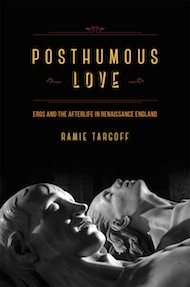Shortlisted for the 2015 ΦBK Christian Gauss Award
By Megan Snell
When Juliet awakens to discover Romeo dead, does she then kill herself with the hope of rejoining him in the afterlife? Or does she use the “happy dagger” with no expectation that their relationship will transcend death? In Posthumous Love: Eros and the Afterlife in Renaissance England, Ramie Targoff argues that the young couple commits suicide in a play that, unlike its sources, disallows any possibility of love enduring beyond the mortal world. Romeo and Juliet joins other English Renaissance literary works that “vehemently rejected” any promise of immortal human intimacy. Through its assertion of love’s mortality, poetry in the period developed aesthetically and emotionally in opposition to an impending, definitive end, offering increasingly “rich and compelling compensations for the lack of posthumous love.”
Targoff’s tour through English Renaissance love poetry begins with a curated assortment of real tomb engravings from the period, grouped together in an imaginary church. These epitaphs for spouses, buried together or alone, differ in their descriptions of a couple’s future, past, or present state. Targoff then places these varying views of the afterlife in the social and religious context of Renaissance England. Protestantism, especially Calvinism, generally encouraged remarriage and thus opposed overlong attachment to the dead, instead rendering death as an opportunity to enter into a grander covenant with Christ. Ultimately, though, the ambiguity of changing theology on this topic of real concern for couples offered English poets “an unusual opportunity for free play.” While the poets of the English Renaissance share an insistence on the impossibility of posthumous attachment, their works vary in how they poeticize this looming, inevitable end to human relationships.
Wyatt’s translation of Petrarch’s Rime sparse provides a telling first episode in Targoff’s literary narrative. Though Petrarch writes poems for his love, Laura, both before and after her death, Wyatt eliminates the emphasis on an erotic bond that can transcend worldly boundaries. The English poet imposes mortal limits by translating almost exclusively the in vive poems, rewriting or ignoring any implied erotic transcendence and rejecting the Neoplatonic idea of achieving salvation through this lasting tie. Love, then, becomes restricted to the secular realm.
For lesser-known Elizabethan sonneteers, the death of a lover marks an escape from the tortures of love. More famous Elizabethan sonnet cycles and poems by Spenser, Drayton, Shakespeare, and Donne employ an alternative device for sustaining love’s memory. Acknowledging erotic finality, they seek literary immortality for their beloved (and incidentally, of course, themselves as authors) through the work itself, so that “this gives life to thee,” as Shakespeare writes in Sonnet 18.
The “mortal poetics” that Targoff defines—that posthumous love is impossible and that this boundary is productive for poets—culminates in her reading of the carpe diem lyric. Challenging the “lighthearted” reputation of the form by positioning it as the apex of her elegant study, Targoff shows it to be the “logical consequence” of earlier literary rejections of posthumous love. While the roots of the carpe diem lyric extend back to antiquity, the English poets raise the stakes of the poem by disallowing the Petrarchan erotic transcendence that emerged in the intervening years. Poets such as Herrick and Marvell urge the intensification of mortal love under temporal limits, embracing the recognition of the relationship’s definitive end. Unlike the sonnets that displace love onto the enduring literary artifact, the carpe diem poets “do not compensate for, but instead capitalize on, the nothingness that awaits lovers in the afterlife in order to fully embrace what this life has to offer.”
Targoff deftly anticipates possible objections to her narrative of restricted eroticism, using apparent outliers to strengthen her case. She contrasts, for example, the pagan romance context of Anthony and Cleopatra, which allows its titular characters to anticipate a postmortem reunion, with that of the Christian world of Romeo and Juliet. Furthermore, the final chapter overtly examines two “limit cases,” poems by Henry King and John Milton that feature grieving husbands wishing to see their dead wives. These poems, though, end with the limitations of the corporeal body precluding any sustainable posthumous connection. It is possible, of course, to find additional exceptions in the large body of Renaissance works. In Henry Chettle’s Tragedy of Hoffman, for example, Lucibella tells her dying lover that “we die, but part to meet / Where joys are certain, pleasures endless, sweet.” Yet a reader of Targoff’s study might then consider how Lucibella recovers and never joins her dead lover in the play. Targoff thus enables the reader to anticipate how other works correspond to her narrative.
With no assumed afterlife for love, the poems Targoff features can appear surprisingly secular and innovative when viewed in the religious framework of Renaissance England. The poets draw from classical and Petrarchan roots to create a new “mortal poetics” particular to the sixteenth and seventeenth centuries. Targoff’s Posthumous Love elucidates the ways in which this conception of death both frames and drives the author’s work, investing the literary experience of the present and its “dying” climax with intense creative energy.
Megan Snell (ΦΒΚ, Colgate University, 2012) is a Ph.D. student in the Department of English at the University of Texas at Austin. The University of Texas at Austin is home to the Alpha of Texas Chapter of Phi Beta Kappa.




